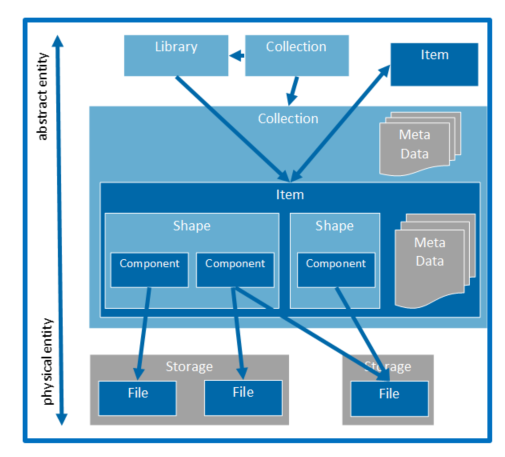Media Repository Vidispine [VF 21.1 UG]
VidiFlow's object and metadata repository is powered by VidiCore, with all of its APIs accessible within VidiFlow. The repository is extremely flexible and versatile and can be adapted to fit varying customer requirements in terms of metadata models. This is made possible by the data model's ability to effectively accommodate attributes originating from multiple sources, systems that overlap in both spatial and temporal dimensions, as well as allowing for hierarchical associations between different metadata entities.
Although VidiFlow users are not required to understand the media repository in great technical depth, understanding the model grants users a more comprehensive view of how objects are organized and structured in Vidispine. This is particularly relevant for scenarios in which customers or users may wish to make use of VidiFlow and Vidispine API resources.
The diagram below depicts the relationship between the different entities in the data model: 
The entities depicted in the illustration above are defined as follows:
- Item (Asset): Usually considered an abstraction of an essence (physical content or entity), holds information about the content (metadata), such as: location of the essence, descriptive information, user access control etc.
- Shape: A shape is a step further towards a true representation of a physical entity. A shape's nature may vary depending on the asset-type. Video shapes may include a high-res essence, a low-res essence, a proxy browsing essence, a thumbnail, or keyframe set. A document on the other hand, may have shapes such as pages, images, or sections. Each shape may have one or multiple components, grouped logically based on the content type.
- Component: A component corresponds to one file (physical) content. E.g. a media shape may have: a container component, a video component, an audio component etc.
- File and Storage: A file entity is a physical file on a file system, stored on a storage entity. VidiFlow manages all files and the file/folder structure on the storage entities.
- Libraries and Collections: A library is a list of items. A library can be created manually, by adding the items to a library, or dynamically, by adding search results to a library. Libraries are useful when performing batch operations. Libraries can also be used when creating rules.
- A collection is a list of items, libraries, and/or collections. Collections may have metadata and access rights, which are applied to the items that belong to the collection. While the library is typically created from a search operation, the collection is often used like a file system folder, to organize items.
For detailed information on the VidiCore API, please visit:
Vidispine Link |
.png)